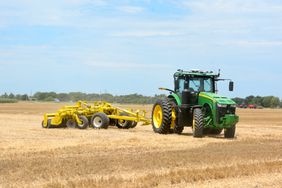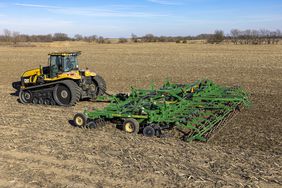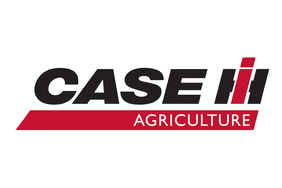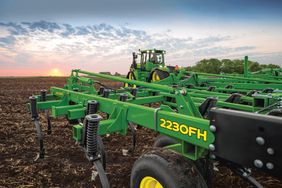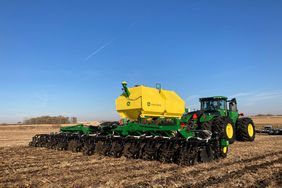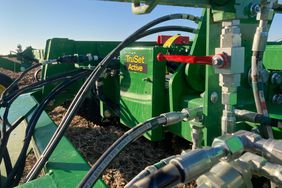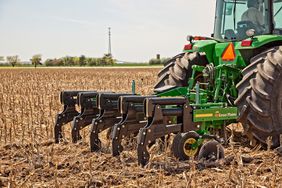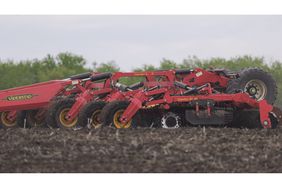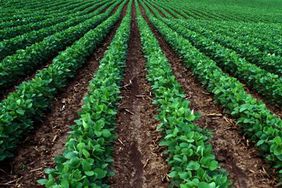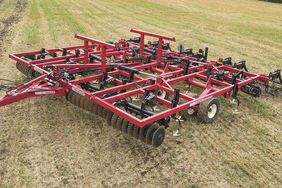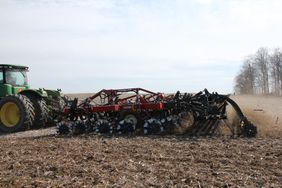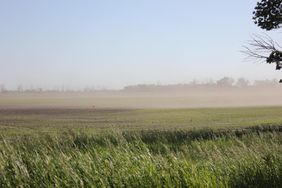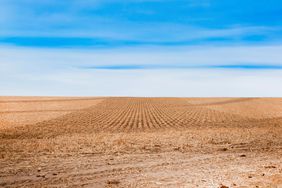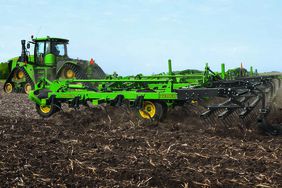:max_bytes(150000):strip_icc()/ilter42-531943406-2000-c3e30f439d834433bbfcda0245d3aa55.jpg)
In 2014, Jodi DeJong- Hughes prepared a field day exhibit with other University of Minnesota (U of M) researchers.
"We created a soil with alternating layers of sand and clay through which we ran a disk ripper," recalls the U of M Extension soil scientist.
As the disk ripper steamed through the soil, something caught their eye, akin to a shiny penny at the bottom of a swimming pool.
"We could see the soil moving 8 to 10 feet in front of the disk ripper," she says. "I knew the disk ripper moved soil, but I didn't think it moved it that far."
On the surface, that short distance seems insignificant. Yet, soil movement keyed by hundreds of tillage trips year after year adds up. Erosion by tillage takes on a disturbing tone in areas with glaciated hilly landscapes.
:max_bytes(150000):strip_icc()/103141020-6a3bead3190a447186f77b21a122d222.jpg)
Soil erosion often conjures up visions of blinding dust storms or soil mired in tar-like gullies. Yet, soil loss keyed by tillage can dwarf those of wind and water erosion. A 1994 erosion analysis by Lobb and other researchers in southwestern Ontario found tillage erosion accounted for at least 70% of total soil loss.
''More soil is moved by tillage erosion than by wind and water erosion combined,'' says Jodi DeJong-Hughes.
A 1994 erosion analysis by Lobb and other researchers in southwestern Ontario found tillage erosion accounted for at least 70% of total soil loss.
Stealthy eroder
Tillage erosion surfaced long before the moldboard plow was just a gleam in the eye of John Deere. When man first tilled with a hoe, soil moved.
"The soil was always pulled downslope, never upslope," says Lobb.
Over time, tillage – whether by hoe or machine – strips topsoil away, particularly on sloping land. Ever notice those yellow to white hues on hilltops before crops mask them? This indicates tillage that has stripped an elevated area right down to the subsoil.
Tillage erosion can even impact the pancake-flat ground of the Red River Valley of North Dakota and Minnesota.
"Even on so-called flat land, tillage will fill surface drains in the field with soil," says Lobb. "Google Earth or aerial images can show diagonal ridges in those fields where soil has been moved by tillage."
Soil losses incurred by tillage erosion can be staggering. DeJong-Hughes cites a 2002-2006 USDA-ARS study at Morris, Minnesota, where a moldboard plow tilled highly erodible land (HEL) slopes.
In 2003, the tillage erosion loss of 27 tons per acre per year was nearly 5½ times as much as the natural 5 tons per acre loss per year.
In 2003, the tillage erosion loss of 27 tons per acre per year was nearly 5½ times as much as the natural 5 tons per acre loss per year. Tillage erosion can then trigger wind and water erosion.
"Once tillage occurs, wind and rain can move the soil as it becomes detached," says Dave White, who served as NRCS chief from 2009 to 2013. This negatively affects both flat and hilly land. That's what happened in the USDA-ARS study.
"When water in the gully area (of the field) moved in, erosion increased another 9 tons per acre," says DeJong-Hughes. "So, 36 tons per acre of soil per year were moved. In these areas, we were getting 45-bushel-per-acre wheat. The farmer was basically farming the subsoil. The phosphorus, potassium, and organic matter in those eroded areas also decreased."
3.8 to 5.7 The years for economic payback for soil landscape restoration in a 2004 to 2008 Manitoba study.
One perk surfaced. "On low-lying areas, 90 bushels per acre wheat was harvested," she says.
Increased yields on lower areas don't always result, though. On a typical slope, tillage erosion can deposit topsoil up to a meter deep, Lobb says.
"The crop often can't benefit from that," he says. It just can't use that much topsoil."
No quick fix
Granted, moldboard plowing HEL soils these days is akin to robbing a bank. Conservation tillage is now seen as the panacea to all that ails soil. Some conservation tillage tools, though, worsen erosion. Chisel plowing at high speeds can move more soil than moldboard plowing, says Lobb.
"It's like taking a road grader over the field," he says.
No-till works better. Just don't expect it to work miracles on high eroded areas.
"Just stopping tillage will not change the situation," says Lobb. "It just stops it from getting worse."
Despite its name, no-till uses some tillage to clear a seed path.
High-disturbance openers, such as hoes and sweeps and injection units, key tillage that leaves at least 50% of the soil surface exposed to subsequent wind and water erosion, says Lobb.
"With high-disturbance seeding, we still scrape off topsoil," says Lobb. He notes some early Canadian no-tillers were surprised that higher yields didn't result on these areas.
"Improving yields on eroded hilltops means rebuilding the soil," says Lobb. "There was no biological capacity in those areas to build up the soil with more organic matter. The topsoil was scraped off."
What to do?
Farmers still have to farm using some form of tillage, whether it's conventional tillage or the slight tillage incurred under no-till.
Still, chin up. The following steps can minimize tillage erosion. In the case of tools like cover crops, farmers may even begin to rebuild tillage-eroded areas.
Study yield monitors and maps.
Slow down.
Steady your speed.
:max_bytes(150000):strip_icc()/TruSet-24b71c02929a4733b6662b2de414922d.jpg)
Vary tillage depth.
Move residue, not soil.
Rebuild the soil.
Don't give up
Mother Nature took centuries to build topsoil. It won't come back overnight. Recognizing that tillage erosion occurs is the first step to reclaiming soil.
"If you do things right, the soil can bounce back," says DeJong-Hughes.
Restoring landscapes
Chinese farmers historically managed tillage erosion in moving soil from low areas to higher ones by bucket brigade.
North American farmers can use the same concept. "Just like in China, this entails moving soil up from the bottom to the top," says David Lobb, a University of Manitoba soil scientist. "This just does it mechanically."
Soil landscape restoration uses road construction scrapers to move topsoil at the bottom of slopes to top slopes and hilltops. In many cases, a $5,000 to $10,000 scraper pulled behind a field tractor does the job, says Lobb.
Moving On Up
Ivan and Brian DeJong, two brothers who own Youngfield Farms Ltd. near Nestleton in southern Ontario, were first tipped off to declining yields on sidehills by combine yield monitors. Readings indicated yields on sidehills eroded by tillage were 50% that of the average field yield.
So, using a scraper hooked to a tractor, they moved 2 to 3 inches of topsoil at the bottom of hills to the sidehills. Yield average on mitigated slopes zoomed from 60% of field average to 90% of field averages after four years on their wheat, corn, and soybeans.
"We are so convinced that it works, we plan to use this method whenever we pick up new farms," says Ivan DeJong.
The DeJongs typically move soil following wheat harvest in early August. "That is a time when it is normally drier and we do less (compaction) damage," he says.
Risk exists. "Heavy rains can wash the soil back down the hill," says DeJong. The brothers reduce this risk by nurturing a cover crop of volunteer wheat, tillage radishes, and Austrian winter peas.
The DeJongs' experience concurs with findings Lobb and other soil scientists have made. A 2004 to 2006 large-scale field study in rolling fields in southwestern Manitoba compared four fields in which soil restoration was compared with control areas. Tillage-eroded sidehills to which 4 inches of bottom-lying topsoil were added had:
- Quicker crop emergence.
- Greater plant populations – 60% greater.
- Larger yields ranging from a 31% increase the first year to 64% the next in one primary site.
In three secondary sites, yield increase ranged from 10% to 133% compared with control plots.
Decreased yields in areas where topsoil is removed is a risk. In the Manitoba study, though, this occurred in just one of three sites where this was monitored. Overall, field yield averages were higher in renovated sites than controlled ones, says Lobb.
"It is one of the most cost-effective land management practices we have," says Lobb.
